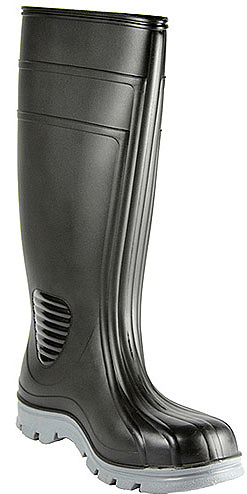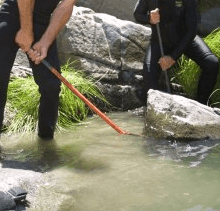 If you are just starting out as a gold prospector you will need to know the basics and how-to behind practices like gold panning. When you first go out to a body of water like a river, pond or creek, if you have a pair of waterproof boots on hand, put them on so that you will protect your feet. Secondly, always bring various shovels, including tools that can move heavy boulders. Without any form of digging, it will be nearly impossible to find gold.
If you are just starting out as a gold prospector you will need to know the basics and how-to behind practices like gold panning. When you first go out to a body of water like a river, pond or creek, if you have a pair of waterproof boots on hand, put them on so that you will protect your feet. Secondly, always bring various shovels, including tools that can move heavy boulders. Without any form of digging, it will be nearly impossible to find gold.
A very useful tool to use when finding gold in your pan is a magnet because it can attract plenty of black sand which is also magnetic. Some of the gold that you collect will be trapped inside thick chunks of black sand, so a magnet can readily expose this.  You should also bring a small bucket to collect concentrates,
You should also bring a small bucket to collect concentrates,  numerous 5 gallon buckets, and a strainer which separates light materials from heavy materials, a snifter bottle, and last but certainly not least a gold pan. If you are going to be looking for gold in places like riverbeds or by the sea, then you will also want to invest in the very best metal detector for use underwater.
numerous 5 gallon buckets, and a strainer which separates light materials from heavy materials, a snifter bottle, and last but certainly not least a gold pan. If you are going to be looking for gold in places like riverbeds or by the sea, then you will also want to invest in the very best metal detector for use underwater.
None of these equipment items are too difficult to find nor too expensive. There are many different kinds of gold pans out there but they all work for the same purpose. The snifter bottle acts as a tiny vacuum as it will suck up the smallest pieces of gold to store them.
 For digging up larger spaces, the regular shovel works best but for smaller spaces like crevasses that are hard to reach, these spaces require smaller tools such as the trowel, a screwdriver or even
For digging up larger spaces, the regular shovel works best but for smaller spaces like crevasses that are hard to reach, these spaces require smaller tools such as the trowel, a screwdriver or even  a spoon as long as it is sturdy enough. The 5 gallon buckets are mainly used for storing other equipment tools and water bottles.
a spoon as long as it is sturdy enough. The 5 gallon buckets are mainly used for storing other equipment tools and water bottles.
 Depending on when you decide to pan for gold, it is important to bring the right pair of gloves with you. If you pan for gold at times when the weather is warm, it is best to wear a pair of leather waterproof gloves to prevent getting blisters. However, if you pan for gold during the winter season, then it would be best to wear a pair of rubber gloves so that you will avoid getting frostbite.
Depending on when you decide to pan for gold, it is important to bring the right pair of gloves with you. If you pan for gold at times when the weather is warm, it is best to wear a pair of leather waterproof gloves to prevent getting blisters. However, if you pan for gold during the winter season, then it would be best to wear a pair of rubber gloves so that you will avoid getting frostbite.
Whether you are in a river, pond or creek, the gold panning process remains the same as you repeatedly shake and sweep the materials that are in your pan until the gold and the heaviest black sand remain.
You start this process by choosing any chunk of gravel that is around you and placing that chunk in your pan. Typically ¾ of your pan will be filled to have a successful shaking and sweeping process, but don’t worry if you have anything less than this.
If there are worthless rocks still in your pan, then get them out as quickly as possible to simplify your search for gold. Make sure that you pick a panning location where you will get enough of a water flow to sweep away any of the junk materials that you have in your pan.
It is also preferred that you do your panning while you either squat, kneel down, bend over or sit on a sturdy surface. Gold panning has a tendency to take energy out of you, so standing up for panning isn’t preferred.
Once you have enough gravel in your pan, dip your filled pan underwater and pick apart the gravel. Make sure to separate any unneeded materials like junk metals and roots. After this is done, everything will be moved around by the water. Your pan should be underwater during this entire time. The mud will promptly float up and out of the pan. Don’t worry if gold also pops out of the pan.
I also like https://m.wikihow.com/Pan-for-Gold for step-by-step instructions.
Eventually you will need to tilt your pan forward to shake back and forth, and you will need to let the rush of the water take the worthless materials away from your pan. From here you will repeat the shaking and sweeping process, and if you are just starting out, you can shake as many times as you would like. Pay attention to any clay that you take out of your pan because sometimes you will find pieces of gold sticking to clay.
Carefully watch these 2 Videos for basic gold panning techniques and how to do it right.
